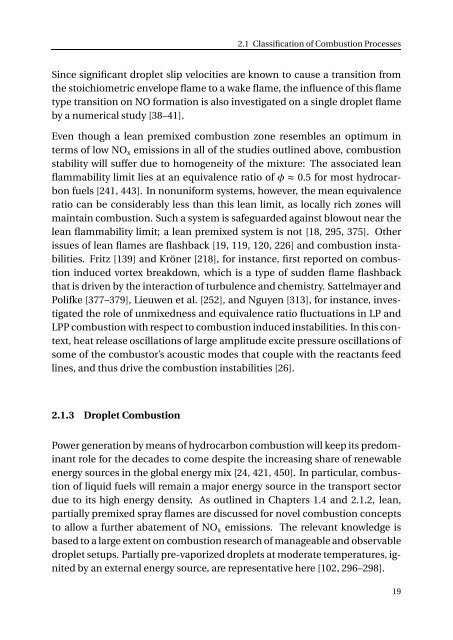On the Formation of Nitrogen Oxides During the Combustion of ...
On the Formation of Nitrogen Oxides During the Combustion of ...
On the Formation of Nitrogen Oxides During the Combustion of ...
You also want an ePaper? Increase the reach of your titles
YUMPU automatically turns print PDFs into web optimized ePapers that Google loves.
2.1 Classification <strong>of</strong> <strong>Combustion</strong> Processes<br />
Since significant droplet slip velocities are known to cause a transition from<br />
<strong>the</strong> stoichiometric envelope flame to a wake flame, <strong>the</strong> influence <strong>of</strong> this flame<br />
type transition on NO formation is also investigated on a single droplet flame<br />
by a numerical study [38–41].<br />
Even though a lean premixed combustion zone resembles an optimum in<br />
terms <strong>of</strong> low NO x emissions in all <strong>of</strong> <strong>the</strong> studies outlined above, combustion<br />
stability will suffer due to homogeneity <strong>of</strong> <strong>the</strong> mixture: The associated lean<br />
flammability limit lies at an equivalence ratio <strong>of</strong> φ ≈ 0.5 for most hydrocarbon<br />
fuels [241, 443]. In nonuniform systems, however, <strong>the</strong> mean equivalence<br />
ratio can be considerably less than this lean limit, as locally rich zones will<br />
maintain combustion. Such a system is safeguarded against blowout near <strong>the</strong><br />
lean flammability limit; a lean premixed system is not [18, 295, 375]. O<strong>the</strong>r<br />
issues <strong>of</strong> lean flames are flashback [19, 119, 120, 226] and combustion instabilities.<br />
Fritz [139] and Kröner [218], for instance, first reported on combustion<br />
induced vortex breakdown, which is a type <strong>of</strong> sudden flame flashback<br />
that is driven by <strong>the</strong> interaction <strong>of</strong> turbulence and chemistry. Sattelmayer and<br />
Polifke [377–379], Lieuwen et al. [252], and Nguyen [313], for instance, investigated<br />
<strong>the</strong> role <strong>of</strong> unmixedness and equivalence ratio fluctuations in LP and<br />
LPP combustion with respect to combustion induced instabilities. In this context,<br />
heat release oscillations <strong>of</strong> large amplitude excite pressure oscillations <strong>of</strong><br />
some <strong>of</strong> <strong>the</strong> combustor’s acoustic modes that couple with <strong>the</strong> reactants feed<br />
lines, and thus drive <strong>the</strong> combustion instabilities [26].<br />
2.1.3 Droplet <strong>Combustion</strong><br />
Power generation by means <strong>of</strong> hydrocarbon combustion will keep its predominant<br />
role for <strong>the</strong> decades to come despite <strong>the</strong> increasing share <strong>of</strong> renewable<br />
energy sources in <strong>the</strong> global energy mix [24, 421, 450]. In particular, combustion<br />
<strong>of</strong> liquid fuels will remain a major energy source in <strong>the</strong> transport sector<br />
due to its high energy density. As outlined in Chapters 1.4 and 2.1.2, lean,<br />
partially premixed spray flames are discussed for novel combustion concepts<br />
to allow a fur<strong>the</strong>r abatement <strong>of</strong> NO x emissions. The relevant knowledge is<br />
based to a large extent on combustion research <strong>of</strong> manageable and observable<br />
droplet setups. Partially pre-vaporized droplets at moderate temperatures, ignited<br />
by an external energy source, are representative here [102, 296–298].<br />
19
















